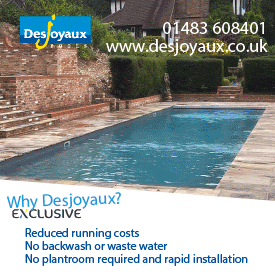Welcome to What Pool & Hot Tub – The UK's No1 Guide for Choosing a Pool, Hot Tub, Spa, Swim Spa or Sauna
Click the cover below to get the latest edition posted to you for free or click here to see the previous issue as a digital edition
Media Pack
To download a PDF copy of the 2024/25 What Pool & Hot Tub media pack (which includes forward features), click here.
Contacts
Editorial & Website:
Jon Wadeson
Tel: 020 8306 8150
Ad Sales: Tony Weston
Tel: 01474 813433
Production: Click to email
Accounts: Click to email
To discuss advertising within What Pool & Hot Tub, please call Tony Weston on 01474 813433 or to email him, click here.
Contacts
Editorial & Website:
Jon Wadeson
Tel: 020 8306 8150
Ad Sales: Tony Weston
Tel: 01474 813433
Production: Click to email
Accounts: Click to email
Pooled resources
Does pool and spa owning have to consume a lot of energy? Hal Norman investigates.Owning a swimming pool or spa gives us an opportunity to relax in some luxury in the privacy of our own homes. For many of us, chilling out in some warm water is the ideal way to forget the stresses of the working week and problems at home. However, global warming and climate change have made water and fossil fuels increasingly valuable resources so is it possible to soak in the pool without a nagging doubt at the back of your mind that your ostensibly harmless pleasure is somehow contributing to the destruction of the planet?
The answer, according to Brian Andrews, Managing Director of Heritage Pools Ltd, can be yes. He explains: “You can make many green choices in the design of an ordinary swimming pool or spa that can help reduce the resulting carbon footprint from the pool.” Most pools are heated by oil or gas but this can be supplemented by solar power.
There are a number of companies offering a solarpowered solution to the problem of heating the pool. For outdoor pools you can buy solar panels which absorb solar energy through a large surface area made of black high molecular polyethylene. Water passing through the panel is heated and pumped back into the pool. So, how many panels will you need? Technical Manager Andy Clark of Powertech Solar Ltd explains: “The number of panels you need depends on the square metreage of the pool. Fifty per cent of the pool square area is used to calculate the quantity of panel absorber area needed. For example a 10 x 5m pool requires twenty-four panels.” The panels can be easily mounted on a roof, a fence or even on the lawn.
When linked to an existing pool pump the reduction in water pressure is minimal. There are also few worries about maintenance as the panels are resistant to swimming pool water and temperature-resistant from -50°C to 115°C.
The company also offers the more expensive option of solar vacuum tube collectors which are suitable for heating both indoor and outdoor pools via a heat exchanger. Another attraction of this option is that it can be incorporated into the domestic heating system, thus defraying the total cost.
Another company working in this area is Riomay, who reckon on supplying six 3 x 1 m solar panels for a 10 x 5 m pool holding 75 m3 of water. This should supply 10800 kW of heat annually, enabling the pool to be used for about eight months in every year. At a relatively small extra cost the solar panels can be rigged up to supply hot water to the house, although the tank will probably have to be replaced by a solar thermal dual heat exchanger tank. The system will automatically switch to conventional power if there is not enough solar power. Riomay also offer to make your solar panels an attractive garden feature by hiding them within the confines of a pergola.
While changes can be made to an existing pool, if you are having a new pool constructed there are a number of things you can do. A darker tile will draw more heat into the pool and a transparent cover will allow sunlight to heat the pool when not in use. A thermal bubble cover will raise a pool’s temperature a few degrees. Installing insulation in the pool walls and floor will also conserve heat and reduce bills. Another option is to install ground source heat pumps, where a 60m hole is bored into the ground to tap into the natural thermal currents that exist at that depth. For hot tubs a company called Eco Spas recovers the heat lost from the spa pump to heat the tub. Unlike many hot tubs which are made of a single acrylic shell mounted in a wooden or metal cabinet, the Eco Spas are moulded in onepiece constructions. The shell of the tub is fully insulated with foam to reduce the heat loss and also to reduce the amount of electricity required.
Humidity
Humidity can be an issue for indoor pools. Unchecked, it can cause damage as the water vapour gets into the walls and ceilings. One solution is provided by Calorex, based near London, who supply swimming pool dehumidfiers which recover and recycle the latent energy provided by humidity to provide heat for the water.
Water consumption
In these days of hosepipe bans water consumption is a big issue. Of course, even the smallest swimming pool uses a great deal of water so how can you enjoy a pool or spa without risking becoming a social pariah? Fortunately, a solution is at hand. A company called Dripool supply automatic pool covers and an eco pool tank recycling system so that you need never have to worry about drought. Very simply, this consists of a 5,000l storage tank and a pump. The pump collects rainwater from the pool cover which then passes into the tank where it is then sterilised, ready to be returned to the pool when required.
Keeping the pool clean
Historically, acid, or most commonly, chlorine, have been regarded as the most effective way to keep the pool walls and floor free of algae. However, the chemicals are potentially health hazards - particularly to asthma sufferers and those of us with sensitive skin - they are expensive and they are abrasive to the tiles. One environmentally friendly solution is to install ionisers which starve the algae of oxygen, thus destroying them before they damage the pool. While it is still necessary to use chlorine, the amount required is reduced by up to ninety percent. As well as the environmental benefit there is a significant cost benefit in reducing chlorine use. What’s more, the pump will last longer because it will not corrode at the same rate as when significant amounts of chlorine are being used.
Off the planet
At the far end of the scale of environmentally friendliness there are companies which offer natural swimming pools, also known as swimming ponds. The pool looks like a garden pond but the water is clear and pure enough for swimming. In the middle is a deep swimming area and this is surrounded by a shallow area planted with flora designed to purify the water. The process of cleaning is therefore biological and natural, rather than chemical. To be effective the pool requires the planting area to be the same size as the swimming area. One potential drawback of this system is that adding a heated system is not recommended. However, the plants will act as a natural solar panel so the water will not be as cold as you might fear.
For more information on swimming pools, hot tubs, swim spas, cold tubs, saunas and much more, click here to sign up to receive your free copy of this years edition.

















